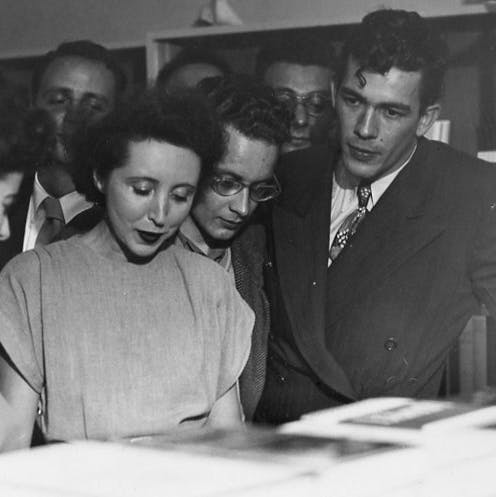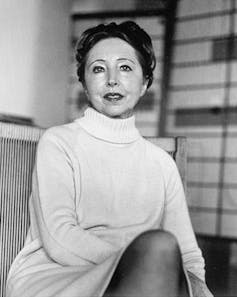
In a new series, writers nominate a book that changed their life – or at least their thinking.
As I combed the library shelves looking for something to read, a 17-year-old girl flush with freedom having escaped the confines of an Australian country convent school, a title caught my eye: The Early Diary of Anaïs Nin 1920-1923.
I too wrote diaries, laden with all the angst of a teenager uncertain of their place in the world.

On the cover was a demure girl with a slightly quizzical expression. I think I had heard her name somewhere, but wasn’t sure who she was. I checked the book out and took it home.
I was instantly hooked. I had never read a book like this before. It laid out all the doubts and despairs of a girl just my age. This girl was ambitious, already dreaming of becoming a writer.
Anaïs Nin dreamed, in all senses. She dreamed of lives and possibilities. She dreamed in slumber and allowed her dreams to leak into the day. As I regularly committed the cardinal social sin of recounting my dreams over breakfast, she seemed a soulmate across oceans and generations.
À lire aussi : The book that changed me: I'm a historian but Tony Birch's poetry opened my eyes to confronting truths about the past
A Bohemian world
Nin started her first diary in 1914 at the age of 11. At her death in 1977, the diaries filled around 150 handwritten notebooks. Initially, many of them were edited and published as seven expurgated volumes in the 1960s. Four volumes of her early diaries, written before 1931, were later published in the 1980s. The unexpurgated diaries started to appear in 1986.
In 1920, Nin was also 17, living in New York, adjusting to American life after a childhood in France and Spain. Her father, well-known musician Joaquin Nin, had abandoned the family to precarious but genteel poverty. She struggled with housework and the mundane expectations of women at the time.
After marriage to the banker Hugh Guiler in 1923, Nin moved to Paris, starting a liaison with the American writer Henry Miller. The complex love triangle of Anaïs, Henry and his wife June Miller became the focus of the diaries, later made into a movie.
As the second world war loomed Nin, Miller and her new lover Gonzalo Moré fled to the US. Here she started practising as a psychoanalyst, set up her own printing press, and published several novels with mysterious, poetic titles: Ladders to Fire, the Four-Chambered Heart, a Spy in the House of Love.
I want to live only for ecstasy. Small doses, moderate loves, all half-shades, leave me cold. I like extravagance. Letters which give the postman a stiff back to carry, books which overflow from their covers, sexuality which bursts the thermometer
– The Diary of Anais Nin, 1931-1934
Nin and her circle also became famous for writing erotica, which a mysterious “collector” paid for by the page. Her stories were published in the anthologies Little Birds, Delta of Venus, and Auletris.
À lire aussi : Playing and paying the whore in Little Birds
In 1955, she started a bigamous, bi-coastal relationship with first husband Guiler in New York and second husband Rupert Pole in California. The unexpurgated diary leading up to this event has only recently been published.
Although she never achieved the heights of literary success she longed for, Nin spoke to a cultural moment. The style that initially worked against her found its audience in feminists of the 1960s and 1970s. She was celebrated for her rare ability to articulate the distinct voice of women.
This fragile woman had the heart of a lion. But in the end her body betrayed her. She died of cervical cancer in 1977, just as I was an 11-year-old entering the convent school as a boarder.
‘Mensonges vitals’: vital lies
Nin was unapologetically feminine, revelling in nuance, in texture and emotion. Feelings were not suppressed as female vanity or weakness. They became a resource for self-knowledge, recording the evolution of the self. She found the words to describe inner worlds.
As she wrote of one character in the novel Seduction of the Minotaur,
The farther she travelled into unknown places, unfamiliar places, the more precisely she could find within herself a map showing only the cities of the interior.

In her musings on women and art, arising from furious arguments with Henry Miller (who stole her work and published it as his own), she maintained that women could create their own subjectivity and elude the male gaze.
I read Nin’s diaries at various stages of my life. The early editions were heavily redacted. In the late 1980s, when I was in my twenties, the uncensored diaries started to be released.
Finally truths hinted at were revealed. And they were shocking.
Most notoriously, Nin seduced her own father and abandoned him in an act of revenge for the abandonment of her childhood. The volume “Incest”, published in 1992, is abhorrent at one level, and yet triumphant and transgressive in a way few writers can dare to be.
The critics, however, seemed to object more to the florid language she used to describe the affair than any moral implications.
Une être étoilique (a starry being)
Through Nin’s diaries, I became aware of a universe of other artists and thinkers. They included the experimental film maker Maya Deren; creator of the Theatre of Cruelty Antonin Artaud, who aimed to disrupt the relationship between performers and audience with “organised anarchy”; and the psychoanalyst Otto Rank, one of Freud’s inner circle.
When I came to write my own book about space archaeology, I wanted to explore the relationship between the inner worlds of human emotions and scientific conceptions of outer space.
I turned to Anaïs Nin for inspiration. In a speech given at Hampshire College in the US in 1972 – the year of the last human mission to the Moon, Apollo 17 – she said:
The wider our universe becomes due to science, and the furthest we go – we think we go so far when we go to the Moon – the nearer we need to come to the centre of ourselves in order to interpret this world, in order to find values, in order to give our lives meaning.
Nin was romantic, sensual, rebellious, mercurial, perceptive. She committed unpardonable sins yet scaled heights of creativity and imagination. She lived a life in which no pleasure or risk was repudiated.
Her diaries taught that the quality of a life can be an accumulation of small moments of beauty. That one could refuse to be tamed. That one could be many selves, each rich beyond reckoning.
Alice Gorman ne travaille pas, ne conseille pas, ne possède pas de parts, ne reçoit pas de fonds d'une organisation qui pourrait tirer profit de cet article, et n'a déclaré aucune autre affiliation que son organisme de recherche.
This article was originally published on The Conversation. Read the original article.







